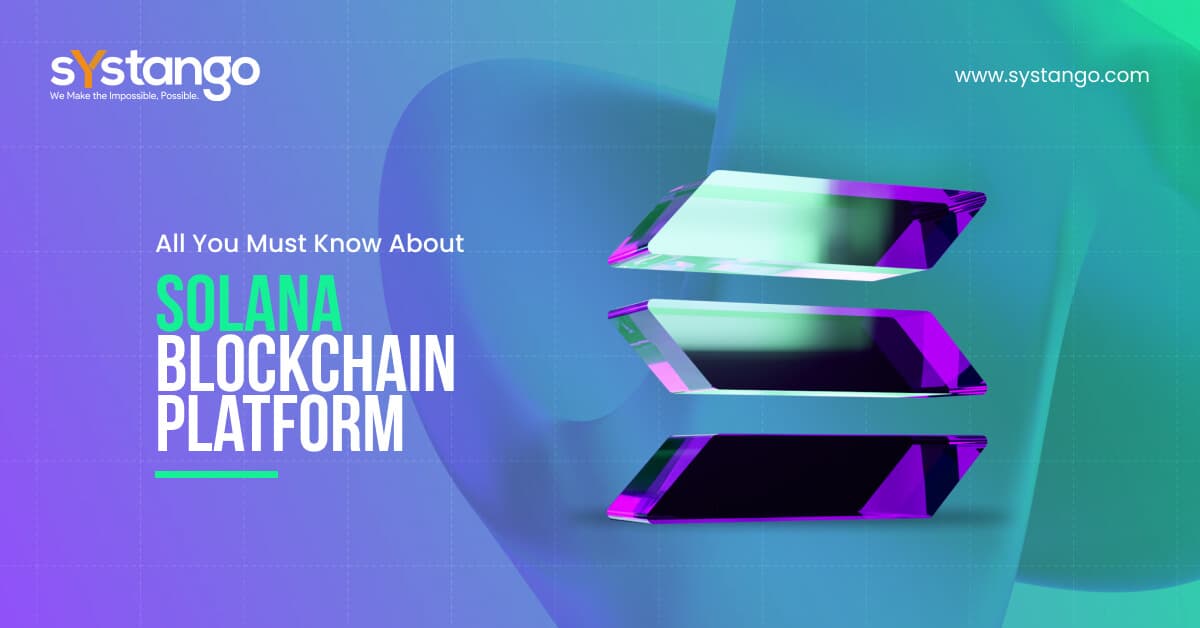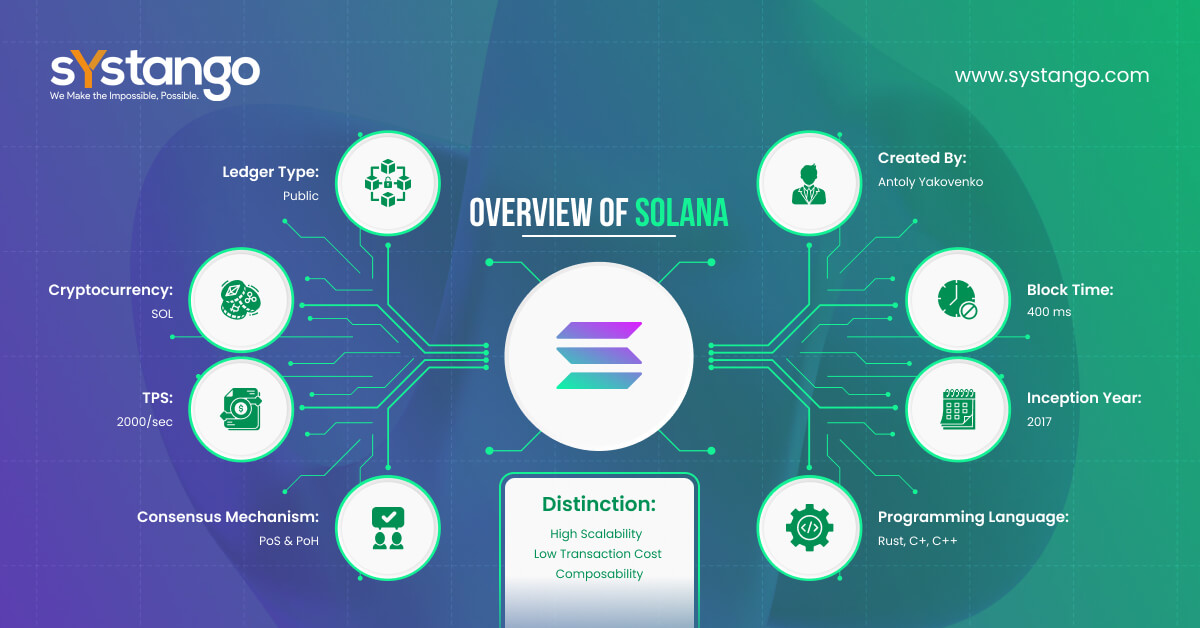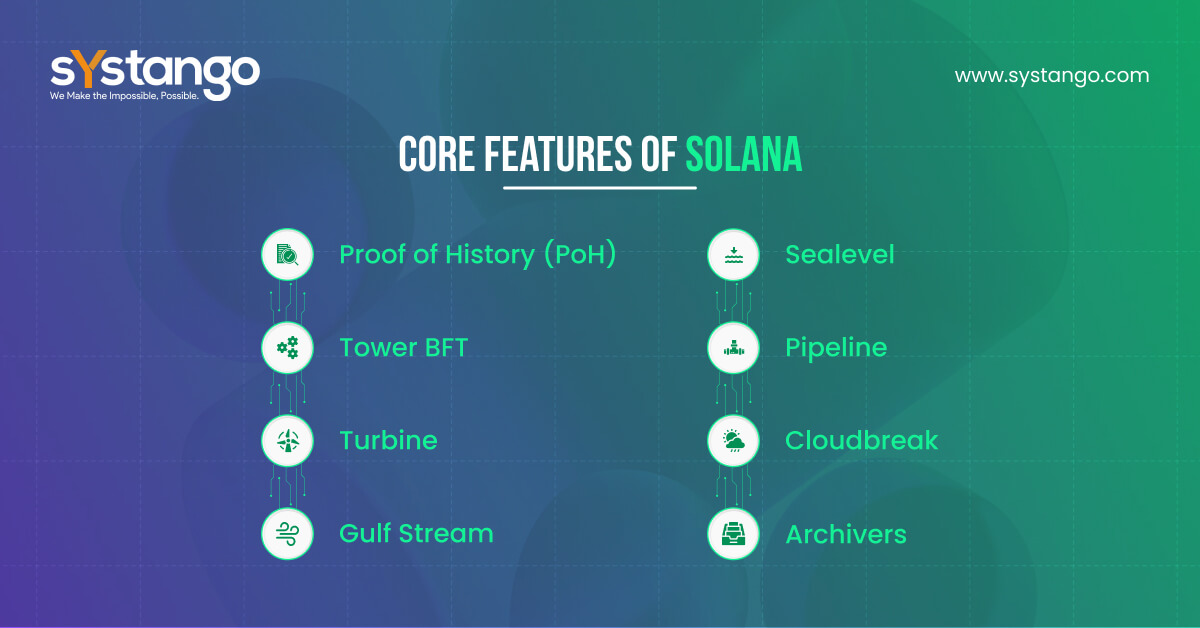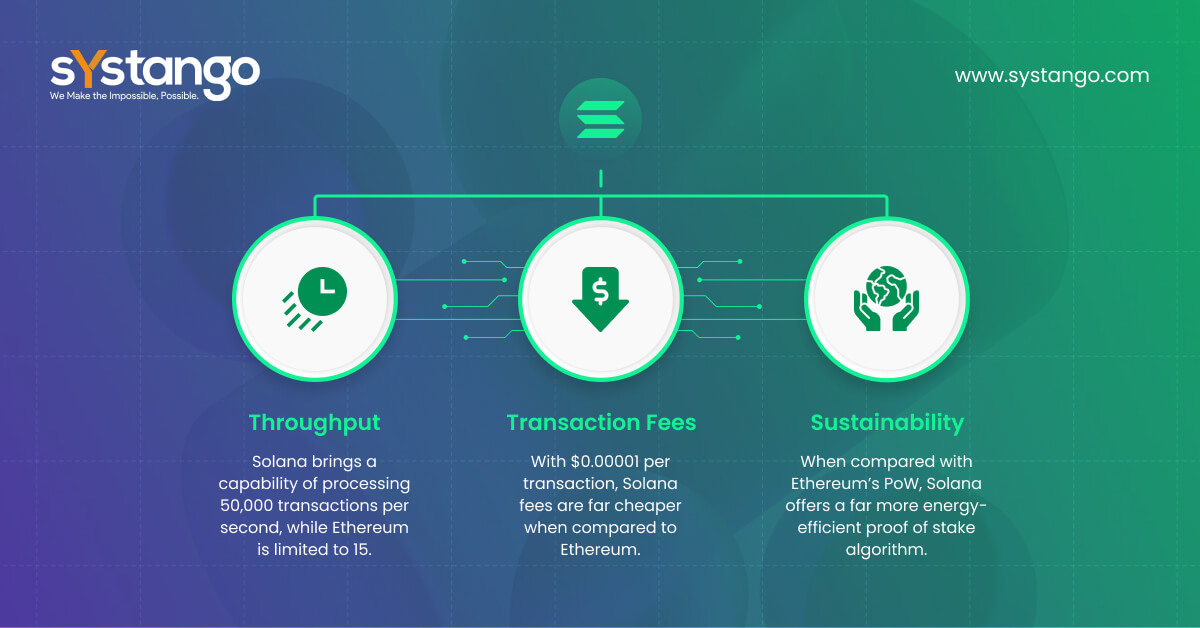All You Must Know About Solana Blockchain Platform
Published on 08 Aug 2022

All You Must Know About Solana Blockchain Platform
Introduced in 2017, Solana has marked incredible growth in the blockchain development industry. That made us write this extensive blog on and all about the Solana blockchain platform.
Lower transaction fees, promising faster operations, greater scalability, with unmatched enterprise-level security; with such outstanding selling points, Solana is on the rise to become the fastest blockchain in the web3 world. It has emerged as an answer to the blockchain trilemma.
Solana has entered the blockchain development market, with some major advancements to first-generation platforms. Its introduction has not only turned the heads of investors but also developers and tech architects are now considering it for dApps and smart contract development.
In Brief
- Solana can process 50,000 transactions per second.
- The platform is self-sufficient and does not require off-chain solutions to avoid bottlenecks.
- Solana delivers combined aspects of Proof-of-stake and Proof-of-history.
- It outperforms other non-Ethereum blockchain platforms in nearly all metrics.
- It is faster and more scalable than any of the other Ethereum competitors
What will you learn?
Is Solana better than Ethereum?
Solana: Blockchain Platform
Referred to as the dawn of next-gen blockchain technology, Solana has emerged to be a fourth-generation blockchain leveraging an open infrastructure to deliver greater scalability. The blockchain platform offers multiple new and distinctive functionalities for users to get remarkable transaction speed and enterprise-level security.
Solana provides an efficient range of decentralized finance (Defi) solutions with an architecture that’s structured to be resilient and expandable. Also, this open-source blockchain platform is referred to as the fastest programmable.
You must note, that Solana is seen as one of the few coins eligible to become a potential inheritor of Ethereum’s (ETH) throne. Let’s discuss all the Solana blockchain platforms, beginning with its launch in 2017.
History of Solana
Solana was introduced by the Solana foundation, which is based in Geneva, Switzerland.
With an aim to compete with Ethereum in the layer one blockchain space, Anatoly Yakovenko founded Solana in 2017. Anatoly’s experience in software development and skills in compression algorithms helped him serve his curiosity to find an alternative to conventional problems with the Ethereum platform.
He worked with Greg Fitzgerald and Eric Williams to address throughput problems in traditional crypto platforms like Bitcoin and Ethereum. The aim of launching this new blockchain platform was to develop a trustless and distributed protocol with eased scalability.
In short, Solana with its modern tech to solve slow transaction speeds and high costs issues establishes itself as one of the fiercest competitors to Ethereum and other blockchain platforms.
How does Solana Work?
Solana works on a combination of Proof-of-History (PoH) and Proof-of-Stack (PoS).
The above combination contrasts the Proof-of-Work (PoW) mechanism, which is used by Ethereum and other traditional blockchain platforms. PoS is more environmentally friendly.
You might ask, what’s so great about this combination of PoS and PoH?
Well, it’s also just another way to reward miners or validators on the blockchain network, in the case of Solana users who are rewarded with SOL. You must also know that Solana lets end users delegate their stake to any validator, who can pass the rewards on to them for a particular fee (yes! It can be referred to as outsourcing as well).
Core Features of Solana
What makes Solana unique from other blockchain platforms? Let’s begin answering this with the eight core elements of the SOL network. Below is a brief description of all the core features that Solana has to offer to its users.
Proof of History: Clock before consensus
Understand PoH as a pre-consensus clock of the SOL network that helps clock consensus on time and sequence the transactions. With this feature, the network gains the capability to secure a synchronous time cryptographically for the network.
PoH on Solana considerably reduces transaction overhead and the nodes don’t have to work in coordination with each other on the network.
Tower BFT: PoH-optimized version of PBFT
Tower BFT can be understood as a tailored Practical Byzantine Fault Toleration for Proof of History networks. It acts as a critical element to capitalize on the benefits of the synchronized clock. With this in the network, we tend to achieve consensus without any messaging overheads or incurring any massive transaction latency.
Turbine: Block propagation protocol
Turbine is the technological feature that is the reason behind Solana’s scalability.
Normally, the entire block size may reach up to 128 MB. Instead of transmitting the whole block in one go, Solana propagates the blocks in the form of packets.
Curious to know, how it is done.
If a block of 128 MB size has to be transmitted on Solana, a leading validator will break it into packets of 64 KB size, making a total of 2000 packets to be transmitted.
Now, these 2000 packers will be assigned and transmitted by 2000 individual validators on the network.
By breaking data into smaller packets, Turbine protocol not only achieves easier data transmission but also boosts the overall throughput settlement.
Gulf Stream: Mempool-less Transaction Forwarding
The first question you might have is, what are mempools?
The number of unconfirmed transactions, waiting to get processed in Bitcoin or Ethereum networks are referred to as Mempools. On the majority of blockchain platforms, as the amount of activity increases so does the strain on validators. Ultimately, growing the mempool queues exponentially.
Gulf Stream is Solana’s answer to the mempool problem.
The functional features of Gulf Stream ensure reaching 50,000 transactions per second on the SOL network.
Sealevel: Parallel Smart Contracts Run-time
Consider Sealevel as a hyper-parallelized transaction processing engine that’s being utilized for scaling horizontally across various GPUs and SSDs.
Running smart contracts on first-generation blockchain platforms like EOS and Ethereum has always been intensive. They have been only able to run single smart contracts at a time.
Now, imagine if there are countless users on a blockchain platform who are performing a myriad of tasks on different applications, playing games, minting NFTs, and transacting decentralized finance. Such a scenario would demand the network to constantly fire smart contracts in the background. However, many of these tasks would sit in the mempool queues in the first-generation blockchain platforms.
Solana helps counter the single-threaded runtime’s slow paradigm. Sealevel runtime allows Solana to run thousands of smart contracts in parallel on its network.
Pipeline: A transaction processing unit
Pipeline feature on the Solana network helps in validation optimization and hence is referred to as the transaction processing unit.
In order to process the transactions, the network assigns a stream of input data to different hardware components. In this way, the mechanism supports quick validation and replication of information around transactions on various nodes in the network.
Cloudbreak: Horizontally-scaled database
Cloudbreak is a memory mechanism employed by the Solana network to keep track of participants’ balances.
The guiding principle behind Cloudbreak on Solana is to design software that gets out of the way of its hardware and allows 100% utilization. It organizes the account database in such a way that it becomes easier to read and write concurrently. Read more about how it’s done from Solana founder Anatoly Yakovenko.
With Cloudbreak’s horizontally scaled accounts database, Solana blockchain achieves the desired levels of scalability.
Archivers: Distributed ledger storage
Another innovative feature that Solana has to offer is Archivers, a distributed ledger storage, where users can offload data from validators to a network of nodes.
Archivers must signal to the network that they have available space for storing data. The network then assigns data to each Archiver based on the total available storage and the desired replication rate. Archivers download the data from the consensus validators and are periodically challenged to prove they are storing it. They are awarded a portion of the inflation for their efforts.
These archivers are lightweight and offer petabytes of blockchain data storage. Archivers are also subject to audits to ensure data integrity.
SOL: Native Crypto of Solana
The SOL cryptocurrency is a critical element for upkeep and operations on the Solana platform.
Just like any other blockchain development platform, Solana also rewards all the associated delegators and validators with newly minted native cryptocurrency. Not just this, based on the number of SOLs stacked, users receive considerable transaction fees as well.
SOL token owners also gain privileged access to a suite of projects being built on the Solana platform.
Uses of SOL on Solana
Pay for Transactions
Similar to ETH for Ethereum, all the transactions taking place on Solana take place with an exchange of SOL tokens. The gas fees are made in SOL.
Rewards for Staking SOL
Users of the Solana network can stake SOL to become validators and gain the right to validate transactions. However, most users prefer delegating their stake to a validator and enjoy reaping their earned staking rewards.
Is Solana a better investment than Ethereum?
Solana is undoubtedly better in all tech aspects than Ethereum. Here’s our take on why Solana is a better investment than Ethereum:
Throughput
Solana brings a capability of processing 50,000 transactions per second, while Ethereum is limited to 15.
Transaction Fees
With $0.00001 per transaction, Solana fees are far cheaper when compared to Ethereum.
Sustainability
When compared with Ethereum’s PoW, Solana offers a far more energy-efficient proof of stake algorithm.
However, Ethereum does sweep Solana through its massive popularity in the decentralized blockchain development industry. But that doesn’t mean Solana cannot catch up to Ethereum’s adoption.
Solana is able to raise hefty funds from leaders in the decentralized industry to grow and better its ecosystem.
Takeaway
When compared to modern peers, Solana is undoubtedly one of the most performant and promising permissionless blockchain platforms.
We believe Solana holds the capability of solving numerous traditional issues faced by users and blockchain developers around the world. With a strong foundation of efficient consensus algorithms, the platform displays signs of rapid growth in the Web3 market.
Related posts
Blockchain
VoidAI
Bittensor
Cross-Chain Infrastructure
AI + Blockchain
Web3 AI
Inside VoidAI: Building Cross-Chain Economic Infrastructure for Bittensor
06 Jan 2026
Web 3
Blockchain
Inside Bittensor: How Decentralised Machine Learning Is Redefining AI Collaboration
10 Nov 2025
Let’s talk, no strings attached.


